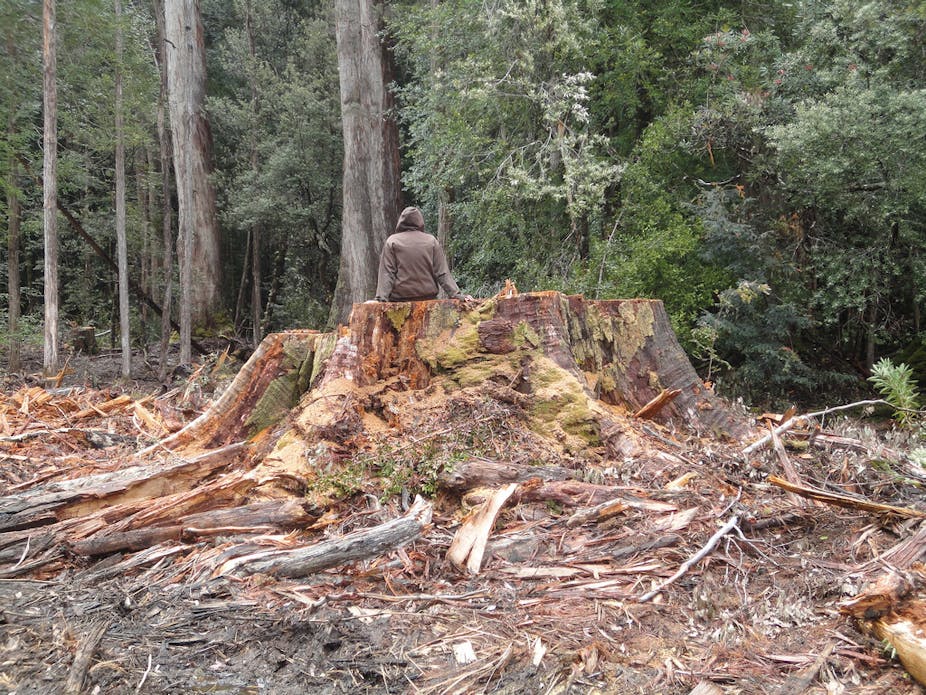There are many jubilant Tasmanians this week celebrating the death of the Tasmanian Forests Agreement now that the forest industry has endorsed the government’s mandate to tear up the deal. I am not one of them.
For all its flaws, it was the state’s best hope to end the forest wars and establish a new forestry settlement.
With the agreement now in tatters, all sides are once again gearing up for a new round of conflict.
Ironically, the Liberals, who are supposed to understand markets, are about to find out how they really work.
Electoral politics
On 14 March Tasmanians delivered a thumping electoral victory to the State Liberal Party.
Voters in the electorates most deeply affected by the forestry downturn — Braddon, Lyons and Bass — emphatically rejected the ALP and the Greens and the Tasmanian Forests Agreement they had helped broker. The deal — between environmental groups, forest industry, and government — would have secured high-quality logs for the forestry industry, and set aside a further half million hectares of forest for protection.
While the outgoing ALP was on the nose after 16 years in power and over its 2010 power-sharing arrangement with the Greens, the election was also fought over competing explanations for the State’s ailing forest industry and visions for its recovery.
According to the ALP and the Greens, the 2008 Global Financial Crisis induced a once-in-a-generation structural crisis in the industry. The vision of the industry embodied in the TFA was a timely and balanced response aimed at creating a smaller, more sustainable, and more secure industry.
The Liberals disagreed, insisting that the industry’s crisis was cyclical not structural, and that markets would recover and new ones be discovered once the GFC storm had passed. The forests should be opened up again to logging to take advantage of the next market upturn.
Clearly many voters are hoping the Liberals’ analysis is correct and that the recent election will restore the industry to its previous vigour.
Industry trends, however, suggest that such a renaissance of industry fortunes is not going to be easy to engineer.
Tasmania’s timber industry
Tasmania’s forest industry is composed of an export sector producing woodchips, veneer and joinery for foreign markets, and a domestic sector producing speciality timber products for the tourist market.
In the past the export sector shipped large volumes of low-value woodchips at a good profit to the protected Japanese pulp and paper industry.
The model not only generated healthy revenues for Forestry Tasmania and Gunns Ltd, but also provided employment for logging contractors and workers.
The speciality timber and sawmilling industry also benefited because logging freed up supplies of its key resource: bespoke timbers like Blackwood, King Billy Pine, Celery-Top Pine, Myrtle and Sassafras.
Crucially, it provided a market for sawmill “residues”.
When a sawmill produces lumber, mouldings, joinery and speciality products from a log it generates waste in the form of offcuts, chips and sawdust.
When these residues could be sold into the booming woodchip market, it obviated the need to store them onsite and supplemented the earnings of sawmill operators.
But since the demise of the woodchip market has significantly altered the economics of forestry in the state, we need to understand why Japan stopped taking Tasmania’s woodchips.
The Japanese market
The Japanese pulp and paper market has always been highly protected.
This has meant that Japanese importers have been able to pay a premium for Tasmanian woodchips because they have been able to pass the costs on to their own customers.
The GFC was a catalyst for significant structural change in the Japanese pulp and paper industry. The industry began to close mills and shift offshore resulting in a substantial drop in woodchip demand.
It also began to demand plantation-based woodchips which were viewed as a superior feedstock to native forest woodchips; and Forest Stewardship Council-certified woodchips to meet the requirements of their clients, publishers and retailers.
With Japan’s pulp and paper industry in decline and China’s on the rise, it may be logical to expect that the next big woodchip boom will occur there.
But China’s market is more open and competitive than Japan’s. And while it is becoming a major importer of woodchips, it prefers to source these from low-cost producers like Vietnam, Thailand and Indonesia.
The high price of the Australian dollar and our high labour costs also militate against any easy growth in the Tasmanian woodchip sector.
In the past, both Forestry Tasmania and Gunns Ltd have found exporting woodchips to China a loss-making activity.
If the above analysis is correct, then the TFA at least recognised that real structural change had occurred in the Tasmanian industry.
The TFA settlement
The TFA was the outcome of negotiations between large, institutionalised, business, labour and environmental groups with a focus on export markets.
Those left out—specialty timber producers, grassroots environmental groups, farmers and local councils—vehemently objected to its structure, modus operandi and outcomes.
The compromise reached—reserving large additional tracts of high-conservation value forests in exchange for rights to log native forests and a $250 million dollar plus compensation package—satisfied some but outraged others.
While their outrage may be understandable, it is hard to see how tearing up the TFA will generate a renaissance in Tasmania’s forest industry.
Freeing up supply only works if there are markets for the products produced.
And at the moment, it is easier to see markets, especially export markets, closing rather than opening under the Liberal, winner-take-all strategy.

